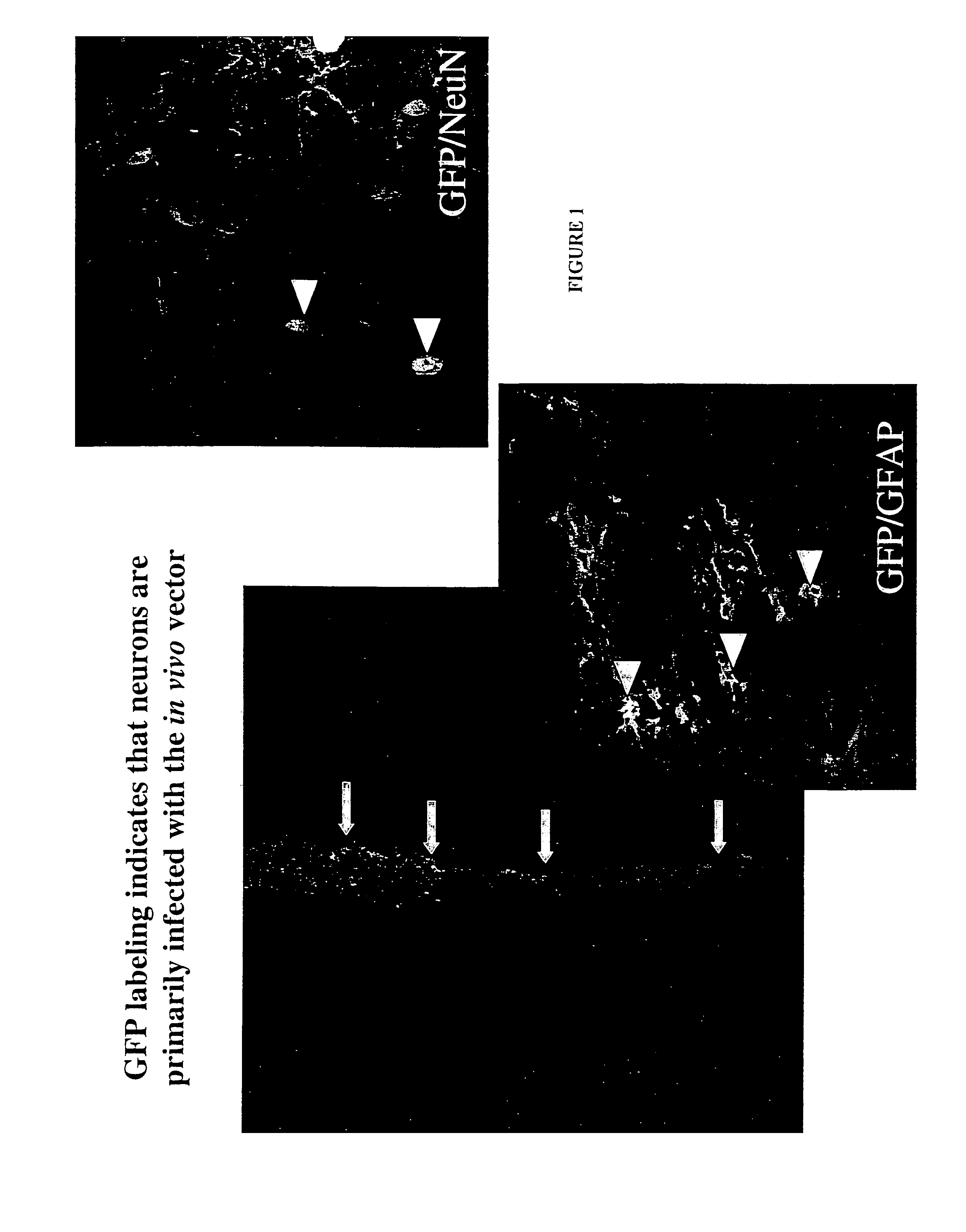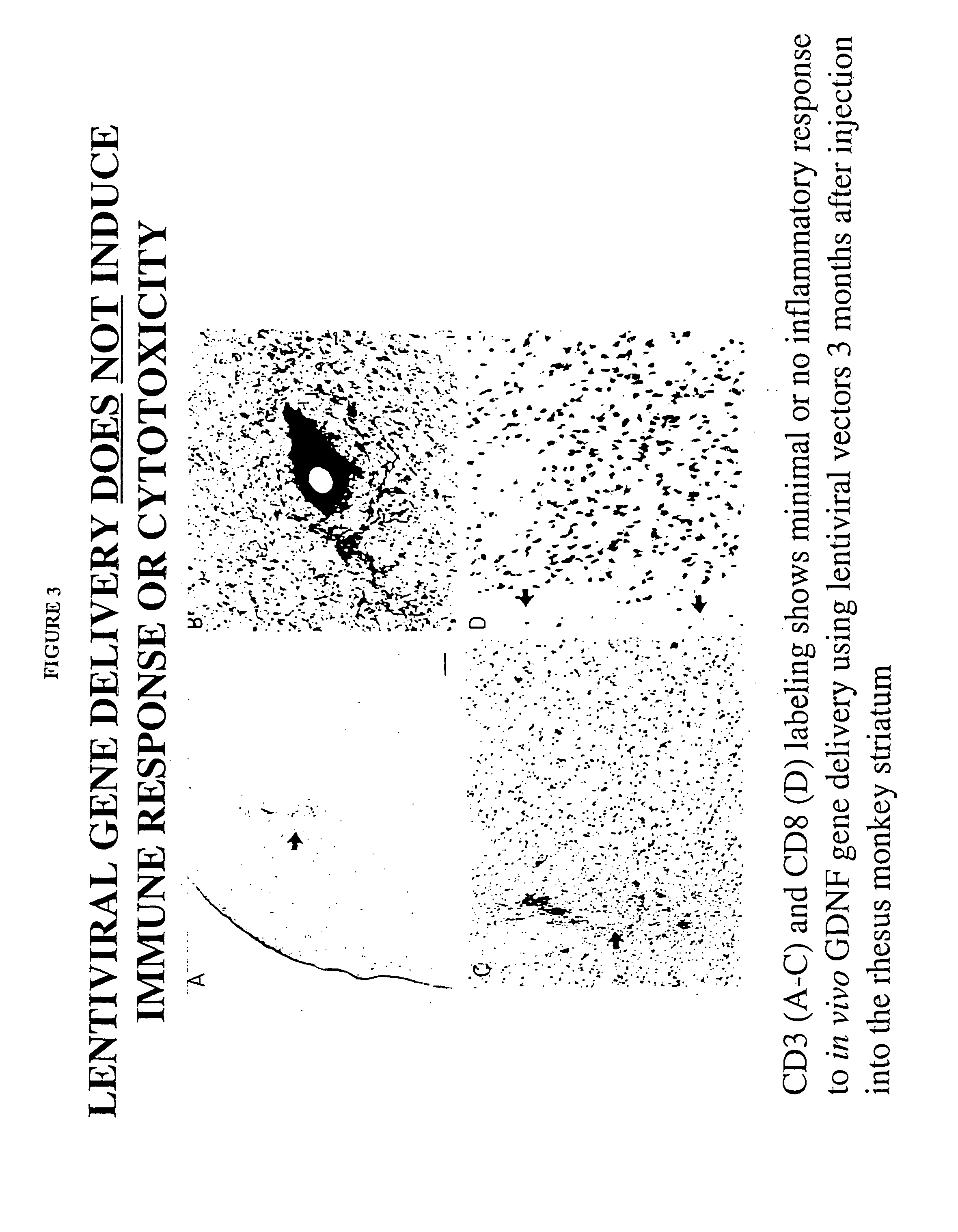Methods for therapy of neurodegenerative disease of the brain
a neurodegenerative disease and brain technology, applied in the direction of biocide, peptide/protein ingredients, genetic material ingredients, etc., can solve the problems of unidentified effective delivery methods and dosing parameters, unfavorable clinical treatment, and inability to achieve clinical administration. to achieve the effect of avoiding potential adverse effects
- Summary
- Abstract
- Description
- Claims
- Application Information
AI Technical Summary
Benefits of technology
Problems solved by technology
Method used
Image
Examples
example i
Adeno-Associated Virus Vector Construction and Viral Particle Production
[0058]For adeno-associated viral vector construction, an expression cassette was cloned containing the following elements: 1) cytomegalovirus promoter (CMVie); 2) a multiple cloning site; 3) an internal ribosome entry site followed by the coding sequence for the active, β-sequence of human nerve growth factor (NGF) or the enhanced form of green fluorescent protein (EGFP); and, 4) a SV40 polyadenylation sequence.
[0059]The complete cassette was cloned into the vector psub201 (American Type Culture Collection) after XbaI digestion to remove the AAV coding sequences. For NGF expression the coding sequence for human NGF (see, GENBANK Accession No. X52599) was inserted into the multiple cloning site of psub-CXIE resulting in the vector psub-CXIE-NGF. This vector, termed psub-CXIE, was used to prepare control GFP expressing virus particles. Thus, this vector was used for the production of particles coding for NGF and G...
example ii
In Vivo Gene Transfer in an Animal Model of Cholinergic Cell Death
[0061]Animals received injections of adeno-associated viral (AAV) vector into an in vivo rat model of cholinergic cell death, to determine the extent and parameters of AAV-NGF vector delivery to prevent neuronal degeneration using in vivo gene delivery. To prepare the animal model, adult Fischer 344 rats underwent fornix transections to induce basal forebrain cholinergic neuronal death. NGF-AAV vector (CXIE-NGF) or control, EGFP-AAV vector (CXIE) was injected into the cholinergic basal forebrain at a range of 2.5 to 10 μl of stock vector solution containing from 1010–1012 particles per ml (neurotrophic composition). Particles were injected over a time period of 3–5 min. into the right hemisphere at the following coordinates: AP −0.3; ML −0.5; DV −6 from brain surface. The skin was closed and animals were allowed to survive for 2–4 weeks.
[0062]AAV vector delivery induced increasing zones of transfection with increasing...
example iii
Model of Alzheimer's Disease through Aging in Primates
[0064]Twelve aged and four adult non-aged Macaca mulatta (rhesus) monkeys were experimental subjects. Non-aged animals (n=4, mean age=9.64±1.90 yrs) did not undergo surgical procedures and their intact brains were studied. Aged monkeys were divided into two experimental groups: NGF recipients (n=6, mean age=22.55±0.56 yrs) and control subjects (n=6, mean age=23.51±1.07 yrs). All procedures and animal care adhered strictly to NIH, AAALAC, USDA, Society for Neuroscience, and internal institutional guidelines (of the University of California, San Diego) for experimental animal health, safety and comfort.
PUM
 Login to View More
Login to View More Abstract
Description
Claims
Application Information
 Login to View More
Login to View More - R&D
- Intellectual Property
- Life Sciences
- Materials
- Tech Scout
- Unparalleled Data Quality
- Higher Quality Content
- 60% Fewer Hallucinations
Browse by: Latest US Patents, China's latest patents, Technical Efficacy Thesaurus, Application Domain, Technology Topic, Popular Technical Reports.
© 2025 PatSnap. All rights reserved.Legal|Privacy policy|Modern Slavery Act Transparency Statement|Sitemap|About US| Contact US: help@patsnap.com



